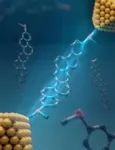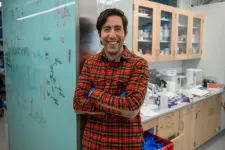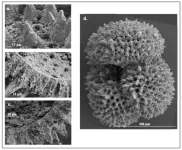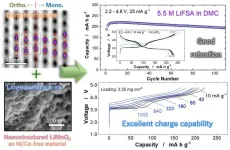(Press-News.org) As electronic devices continue to get smaller and smaller, physical size limitations are beginning to disrupt the trend of doubling transistor density on silicon-based microchips approximately every two years according to Moore’s law. Molecular electronics—the use of single molecules as the building blocks for electronic components—offers a potential pathway for the continued miniaturization of small-scale electronic devices. Devices that utilize molecular electronics require precise control over the flow of electrical current. However, the dynamic nature of these single molecule components affects device performance and impacts reproducibility.
University of Illinois Urbana-Champaign researchers report a unique strategy for controlling molecular conductance by using molecules with rigid backbones—such as ladder-type molecules, known as being shape-persistent. Further, they have demonstrated a straightforward “one-pot” method for synthesizing such molecules. The principles were then applied to the synthesis of a butterfly-like molecule, showing the strategy’s generality for controlling molecular conductance.
This new research, led by Charles Schroeder, the James Economy Professor of Materials Science and Engineering and Professor of Chemical and Biomolecular Engineering, along with postdoc Xiaolin Liu and graduate student Hao Yang, was recently published in the journal Nature Chemistry.
“In the field of molecular electronics, you have to consider the flexibility and the motion of the molecules and how that affects the functional properties,” Schroeder says. “And it turns out that plays a significant role in the electronic properties of molecules. To overcome this challenge and achieve a constant conductivity regardless of the conformation, our solution was to prepare molecules with rigid backbones.”
One of the main challenges for molecular electronics is that many organic molecules are flexible and have multiple molecular conformations—the arrangement of atoms due to bond rotation—with each conformation potentially resulting in a different electrical conductance. Liu explains, “For a molecule with multiple conformations, the variation in conductance is very large, sometimes 1000 times different. We decided to use ladder-type molecules, which are shape persistent, and they showed a stable set of rigid conformations so that we can achieve stable and robust molecular junction conductance.”
Ladder-type molecules are a class of molecules that contain an uninterrupted sequence of chemical rings with at least two shared atoms between rings, which “locks” the molecule into a certain conformation. Such a structure provides shape-persistence and constrains the rotational movement of the molecule, which also minimizes conductance variation.
Having consistent conductance is particularly important when the ultimate goal of molecular electronics is for use in a functional device. This means billions of components that need to have the same electronic properties. “The variation in conductance is one of the issues that has prevented the successful commercialization of molecular electronic devices. It is very difficult to fabricate the large number of identical components necessary and control the molecular conductance in single molecule junctions,” Yang explains. “If we are able to precisely do this, that can help push the commercialization and make electronic devices very small.”
To control the molecular conductance of shape-persistent molecules, the team used a unique one-pot ladderization synthesis strategy that produced chemically diverse, charged ladder molecules. Traditional synthesis methods use costly starting materials and are usually two component reactions, which limits the diversity of the products. Using the one-pot multicomponent strategy, also called modular synthesis, the starting materials are much simpler and commercially available. “We can use many different combinations of those starting materials and make a rich diversity of product molecules suitable for molecular electronics,” Liu says.
Further, Liu and Yang applied the rules they learned from ladder-type molecules and demonstrated the broad applicability of shape persistence by designing, synthesizing and characterizing the electronic properties of a butterfly-like molecule. These molecules have two “wings” of chemical rings, and like ladder molecules, butterfly molecules feature a locked backbone structure and constrained rotation. This will pave the way for the design of other functional materials and ultimately, for more reliable and efficient devices.
Charles Schroeder is also an affiliate of the departments of chemistry and bioengineering, the Materials Research Laboratory and the Beckman Institute for Advanced Science and Technology at Illinois.
Xiaolin Liu is affiliated with the department of chemistry and the Beckman Institute for Advanced Science and Technology at Illinois.
Hao Yang is affiliated with the department of materials science and engineering and the Beckman Institute for Advanced Science and Technology at Illinois.
Other contributors to this work include Jeffrey S. Moore (departments of chemistry and materials science and engineering, the Beckman Institute for Advanced Science and Technology, Illinois), Joaquín Rodríguez-López (department of chemistry, the Beckman Institute for Advanced Science and Technology, Illinois), Qian Chen (departments of chemistry and materials science and engineering, the Beckman Institute for Advanced Science and Technology, Illinois), Adolfo I. B. Romo (department of chemistry, the Beckman Institute for Advanced Science and Technology, Illinois), Oliver Lin (department of chemistry, Illinois), Toby J. Woods (department of chemistry, Illinois), Rajarshi Samajdar (department of chemical and biomolecular engineering, the Beckman Institute for Advanced Science and Technology, Illinois), Hassan Harb (Materials Science Division, Argonne National Laboratory) and Rajeev S. Assary (Materials Science Division, Argonne National Laboratory).
This research was funded by the U.S. Department of Energy Office of Science.
END
Controlling molecular electronics with rigid, ladder-like molecules
2024-08-26
ELSE PRESS RELEASES FROM THIS DATE:
Marine science oxygen produced in the deep sea raises questions about extraterrestrial life
2024-08-26
Over 12,000 feet below the surface of the sea, in a region of the Pacific Ocean known as the Clarion-Clipperton Zone (CCZ), million-year-old rocks cover the seafloor. These rocks may seem lifeless, but nestled between the nooks and crannies on their surfaces, tiny sea creatures and microbes make their home, many uniquely adapted to life in the dark.
These deep-sea rocks, called polymetallic nodules, don’t only host a surprising number of sea critters. A team of scientists that includes Boston University experts has discovered they ...
What microscopic fossilized shells tell us about ancient climate change
2024-08-26
At the end of the Paleocene and beginning of the Eocene epochs, between 59 to 51 million years ago, Earth experienced dramatic warming periods, both gradual periods stretching millions of years and sudden warming events known as hyperthermals.
Driving this planetary heat up were massive emissions of carbon dioxide (CO2) and other greenhouse gases, but other factors like tectonic activity may have also been at play.
New research led by University of Utah geoscientists pairs sea surface temperatures with levels ...
Li-ion batteries show promise as cheap and sustainable alternative to Ni/Co materials
2024-08-26
Lithium-ion (or Li-ion) batteries are heavy hitters when it comes to the world of rechargeable batteries. As electric vehicles become more common in the world, a high-energy, low-cost battery utilizing the abundance of manganese (Mn) can be a sustainable option to become commercially available and utilized in the automobile industry. Currently, batteries used for powering electric vehicles (EVs) are nickel (Ni) and cobalt (Co)-based, which can be expensive and unsustainable for a society with a growing desire for EVs. By switching the positive electrode ...
The Lundquist Institute announces updates to its Board of Directors
2024-08-26
The Lundquist Institute for Biomedical Innovation at Harbor-UCLA Medical Center (TLI) announced updates to its Board of Directors today. TLI welcomes one new distinguished member and thanks the two outgoing members for their invaluable contributions.
“On behalf of the Board, I am delighted that Dr. Bill Dorfman, a global leader in cosmetic dentistry, has joined the TLI Board. Dr. Dorfman's extensive expertise and commitment to philanthropy make him an invaluable addition to our leadership,” said Mitchel Sayare, PhD, TLI Board ...
Research from UTHealth Houston finds parents who recently experienced intimate partner violence had higher potential for parenting stress and child maltreatment
2024-08-26
Parents who recently experienced intimate partner violence reported more parenting stress and higher potential for child maltreatment, and were less likely to use positive parenting strategies, according to UTHealth Houston research published Aug. 26, 2024, in JAMA Pediatrics.
“Our findings demonstrate the collateral damage of domestic violence — that the negative consequences are not limited to the couple and instead have the potential to affect how they parent, and ultimately the health of their children. We must expend every effort to prevent this public health problem,” said Jeff Temple, PhD, ...
Research spotlight: Key regulators of pd-1 in melanoma cells and the immune system’s response
2024-08-26
How would you summarize your study for a lay audience?
Immune checkpoint inhibitors are cancer fighting drugs that help the immune system do its job of detecting and attacking tumor cells. Programmed Cell Death 1 (PD-1) is a common target for this type of drug—it is a protein that sits on the surface of T cells and helps regulate the immune system’s response to neighboring cells, both normal and cancerous. While most research efforts to date have focused on PD-1’s role in T cells, it is also active in many other kinds of cells—including cancer cells as first demonstrated by the Schatton ...
Lighting the way for quantum innovation
2024-08-26
ALBUQUERQUE, N.M. — Sandia National Laboratories and Arizona State University, two research powerhouses, are collaborating to push the boundaries of quantum technology and transform large-scale optical systems into compact integrated microsystems.
Nils Otterstrom, a Sandia physicist specializing in integrated photonics, is at the forefront of scaling down optical systems to the size of a chip. This innovation offers performance advantages and scalability for an array of applications from advanced computing to secure communications.
“Integrated ...
Spin squeezing for all
2024-08-26
Nothing in science can be achieved or understood without measurement. Today, thanks to advances in quantum sensing, scientists can measure things that were once impossible to even imagine: vibrations of atoms, properties of individual photons, fluctuations associated with gravitational waves.
A quantum mechanical trick called “spin squeezing” is widely recognized to hold promise for supercharging the capabilities of the world’s most precise quantum sensors, but it’s been notoriously difficult to achieve. In new research, Harvard physicists describe how they’ve put spin squeezing ...
NSF funds research on the effects of evolution and food webs in climate change response
2024-08-26
Colorado State University is leading a new interdisciplinary research project into the ways predators and prey in sensitive ecosystems may react to climate change based on their physiology, genetics and relationships to each other.
Led by Professor Chris Funk in the Department of Biology, the project is funded by the National Science Foundation’s Organismal Response to Climate Change program and will focus on interactions between cutthroat trout and tailed frogs in Pacific Northwest streams. This approach is one of the first times researchers have tried to test both the effects of evolution and ...
Children's Brain Tumor Network hosts 2024 CBTN Summit to transform scientific research and patient care
2024-08-26
What:
The 2024 CBTN Summit hosted by the Children's Brain Tumor Network (CBTN) assembles the brightest minds in Pediatric Brian Tumor research for this annual conference. The event is free but attendees must register in advance.
Register at network.cbtn.org/cbtn-summit
Where:
In person at AWS Headquarters
Amazon WAS16 Aurora, 1770 Crystal Dr, Arlington, VA 22202
Virtual attendance available worldwide.
When:
October 9-11, 2024
Why:
This event is an opportunity ...









